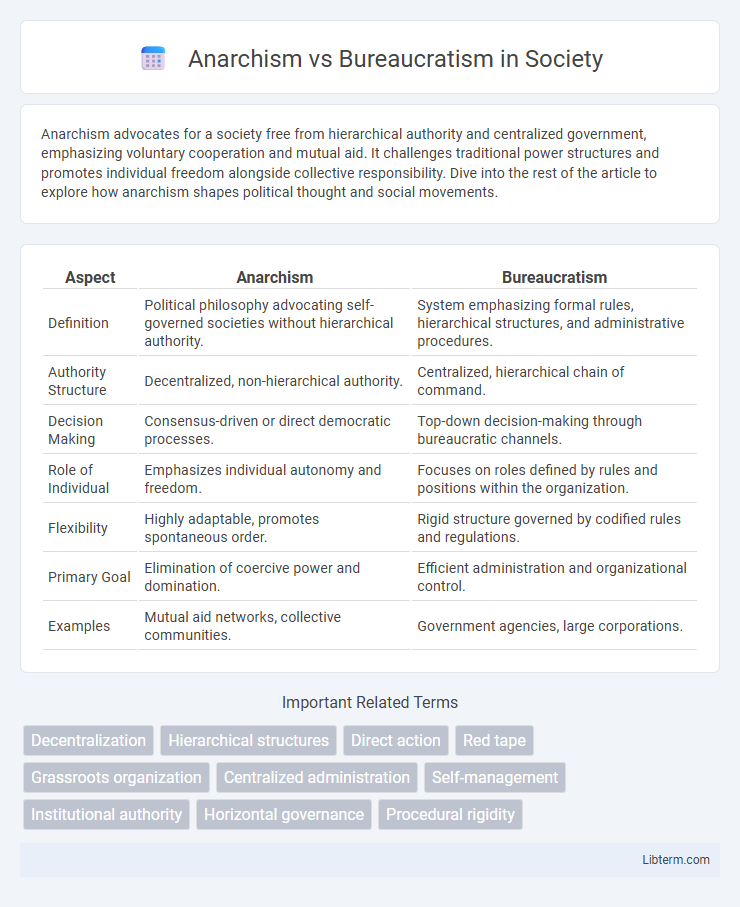Anarchism advocates for a society free from hierarchical authority and centralized government, emphasizing voluntary cooperation and mutual aid. It challenges traditional power structures and promotes individual freedom alongside collective responsibility. Dive into the rest of the article to explore how anarchism shapes political thought and social movements.
Table of Comparison
| Aspect | Anarchism | Bureaucratism |
|---|---|---|
| Definition | Political philosophy advocating self-governed societies without hierarchical authority. | System emphasizing formal rules, hierarchical structures, and administrative procedures. |
| Authority Structure | Decentralized, non-hierarchical authority. | Centralized, hierarchical chain of command. |
| Decision Making | Consensus-driven or direct democratic processes. | Top-down decision-making through bureaucratic channels. |
| Role of Individual | Emphasizes individual autonomy and freedom. | Focuses on roles defined by rules and positions within the organization. |
| Flexibility | Highly adaptable, promotes spontaneous order. | Rigid structure governed by codified rules and regulations. |
| Primary Goal | Elimination of coercive power and domination. | Efficient administration and organizational control. |
| Examples | Mutual aid networks, collective communities. | Government agencies, large corporations. |
Introduction to Anarchism and Bureaucratism
Anarchism advocates for a stateless society where individuals freely cooperate without hierarchical authority or coercive institutions. Bureaucratism emphasizes structured organizations with defined roles and centralized control to enforce rules and maintain order. Understanding the core principles of anarchism and bureaucratism highlights the fundamental tension between decentralized autonomy and institutional governance.
Historical Origins and Evolution
Anarchism originated in the 19th century as a radical critique of centralized state authority and hierarchical institutions, heavily influenced by thinkers like Pierre-Joseph Proudhon and Mikhail Bakunin. Bureaucratism evolved from Max Weber's analysis of rational-legal authority, emphasizing structured administrative systems designed to maintain order and efficiency in complex societies. The historical evolution of anarchism reflects ongoing resistance to bureaucratic domination, while bureaucratism developed alongside the expansion of modern states and capitalist economies to manage growing social complexities.
Core Principles of Anarchism
Anarchism emphasizes the abolition of hierarchical authority and promotes voluntary cooperation, mutual aid, and self-governance as core principles. It rejects bureaucratism's rigid structures, advocating for decentralized, non-coercive social organization where individuals freely associate without imposed power. Key concepts include autonomy, direct democracy, and the dismantling of centralized institutions to achieve true freedom and equality.
Fundamental Traits of Bureaucratism
Bureaucratism is characterized by rigid hierarchical structures, strict adherence to rules, and an emphasis on formal procedures that prioritize order and control over individual autonomy. It promotes centralized decision-making and impersonal authority, often leading to inefficiency and resistance to innovation. This contrasts sharply with anarchism's rejection of imposed authority and advocacy for decentralized, voluntary cooperation.
Power Structures: Decentralization vs Hierarchy
Anarchism promotes decentralized power structures, advocating for autonomous, self-managed communities without central authority, ensuring individual freedom and collective decision-making. Bureaucratism relies on hierarchical power systems, where authority is concentrated in rigid organizational layers that enforce rules and control resources. This fundamental divergence shapes the dynamics of governance, conflict resolution, and social organization between the two ideologies.
Decision-Making Processes Compared
Anarchism emphasizes decentralized decision-making through direct participation and consensus among individuals, eliminating hierarchical authority to foster autonomy and equality. Bureaucratism relies on structured, hierarchical decision-making processes governed by formal rules and procedures to ensure order, consistency, and efficiency in large organizations or governments. While anarchism promotes fluid, collective choices responsive to immediate community needs, bureaucratism prioritizes standardized, top-down control to manage complexity and maintain stability.
Social and Economic Implications
Anarchism advocates for decentralized social structures and the abolition of hierarchical authority, promoting voluntary cooperation and mutual aid as core economic principles. Bureaucratism, characterized by rigid hierarchical administration and centralized control, often leads to inefficiencies, reduced innovation, and limited individual autonomy in both social and economic spheres. The social implications of anarchism emphasize empowerment and community decision-making, whereas bureaucratism tends to perpetuate social stratification and economic disparities through top-down governance.
Case Studies: Real-World Examples
Case studies of anarchism versus bureaucratism illustrate distinct governance outcomes in regions like Rojava and Soviet-era administrations, where decentralized decision-making fostered grassroots empowerment contrasting with rigid hierarchical control. Rojava's autonomous councils emphasize direct democracy and social ecology principles, reducing state bureaucracy while enhancing community participation. In contrast, Soviet bureaucratism centralized power, often stifling individual freedoms and innovation through extensive administrative layers and strict policy enforcement.
Critiques and Controversies
Anarchism critiques bureaucratism for its hierarchical structures, which are seen as inherently oppressive and stifling individual freedom and creativity. Bureaucratism faces controversy over inefficiency and rigid procedures that often lead to alienation and lack of responsiveness within organizations and governments. Both ideologies clash fundamentally on authority legitimacy, with anarchism advocating abolition and bureaucratism emphasizing order and control through established systems.
Future Perspectives and Hybrid Models
Future perspectives on anarchism versus bureaucratism emphasize integrating decentralized governance with structured organizational frameworks to enhance flexibility and accountability. Hybrid models propose combining anarchist principles of autonomy and direct participation with bureaucratic mechanisms for efficiency and scalability, enabling adaptive and resilient systems. These approaches leverage digital technologies and networked communities to balance individual freedom with coordinated decision-making in evolving social and political landscapes.
Anarchism Infographic

 libterm.com
libterm.com